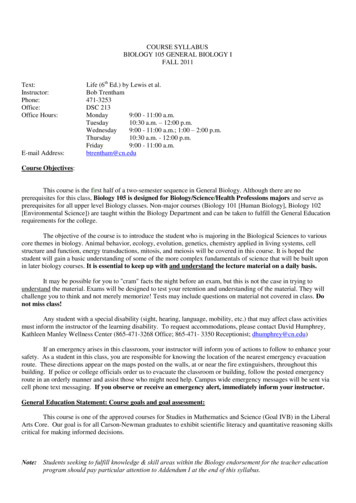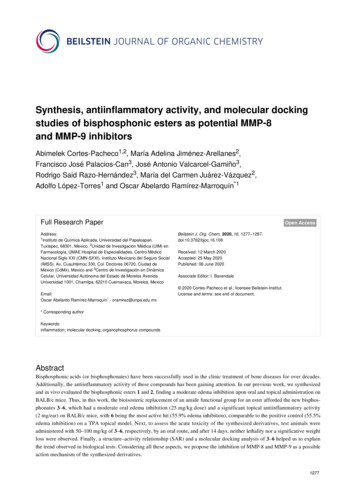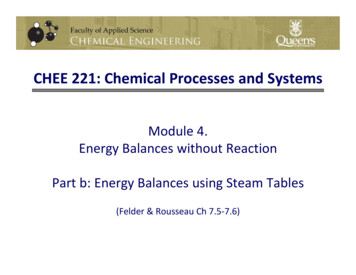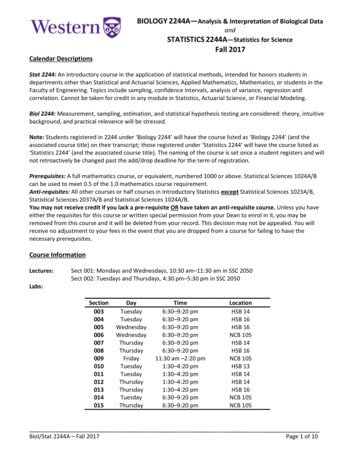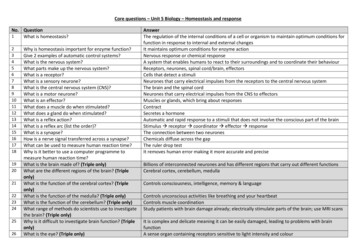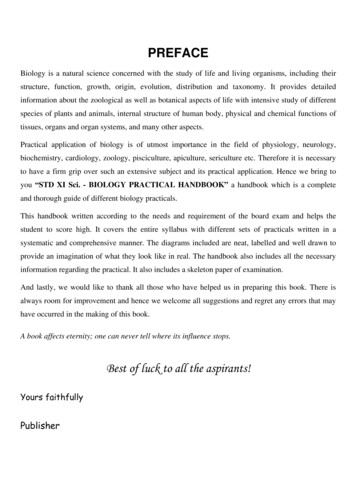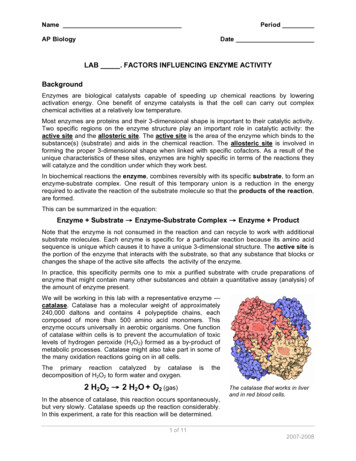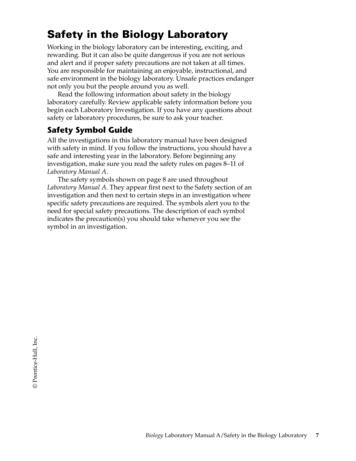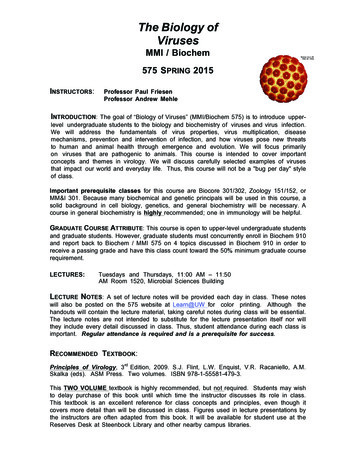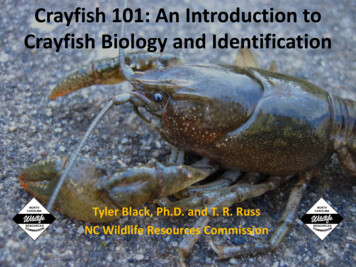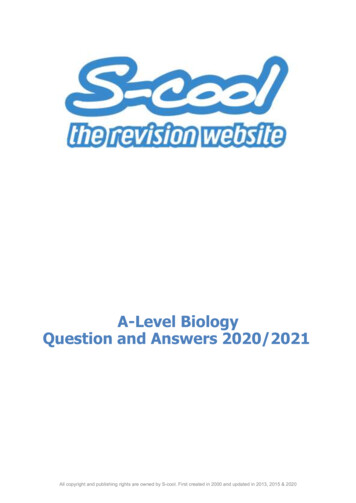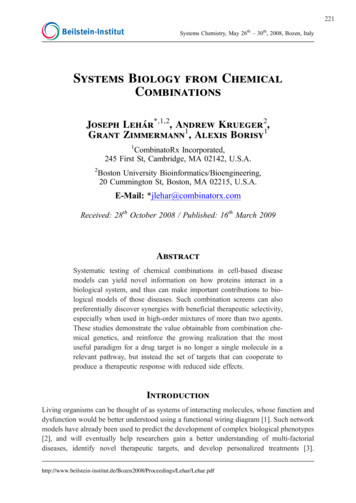
Transcription
221Beilstein-InstitutththSystems Chemistry, May 26 – 30 , 2008, Bozen, ItalySystems Biology from ChemicalCombinationsJoseph Leh r*,1,2, Andrew Krueger2,Grant Zimmermann1, Alexis Borisy11CombinatoRx Incorporated,245 First St, Cambridge, MA 02142, U.S.A.2Boston University Bioinformatics/Bioengineering,20 Cummington St, Boston, MA 02215, U.S.A.E-Mail: *jlehar@combinatorx.comReceived: 28th October 2008 / Published: 16th March 2009AbstractSystematic testing of chemical combinations in cell-based diseasemodels can yield novel information on how proteins interact in abiological system, and thus can make important contributions to biological models of those diseases. Such combination screens can alsopreferentially discover synergies with beneficial therapeutic selectivity,especially when used in high-order mixtures of more than two agents.These studies demonstrate the value obtainable from combination chemical genetics, and reinforce the growing realization that the mostuseful paradigm for a drug target is no longer a single molecule in arelevant pathway, but instead the set of targets that can cooperate toproduce a therapeutic response with reduced side effects.IntroductionLiving organisms can be thought of as systems of interacting molecules, whose function anddysfunction would be better understood using a functional wiring diagram [1]. Such networkmodels have already been used to predict the development of complex biological phenotypes[2], and will eventually help researchers gain a better understanding of multi-factorialdiseases, identify novel therapeutic targets, and develop personalized treatments ceedings/Lehar/Lehar.pdf
222Lehár, J. et al.The staggering complexity of biological systems requires large and diverse sets of data oncomponent connectivity and responses to system perturbations. The core topology of thenetwork is determined using direct interactions between genes, proteins, and metabolites,and the models can then be refined using a biological system’s responses to perturbations,such as drugs, mutations, or environmental changes. All of these approaches can associatenetwork components with functional roles, even without direct interactions connecting them.Combined perturbations shift the focus of genetic and chemical genetic studies from thefunctions of individual genes or proteins to interactions of those components within abiological system [4]. Large efforts to test the viability of double mutants are underway inbacteria [5], yeast [6], and nematodes [7]. Chemicals provide information that is distinctfrom and complementary to genetic perturbations, given the differences between how theymodulate protein functions [8]. The advantages of chemical perturbations are that they cantarget a single domain of a multi-domain protein, allow precise temporal control that iscritical for rapid-acting processes, can target orthologous or paralogous proteins enablingcomparisons between species or redundant functions, and do not directly alter the concentrations of a targeted protein, thus avoiding indirect effects upon multi-protein complexes.Small molecules also lend themselves more readily to combination interventions, makingthem especially useful for integrating systems and chemical biology [9, 10]. Most combinedperturbation studies with combinations have focused on exploring drug sensitivities acrosslarge sets of knockouts are also being undertaken in various model organisms [11, 12] andhuman cells [13]. However, these approaches are increasingly being extended to systematictesting of purely chemical combinations [10, 14]. Here we discuss our work that exploreshow combination studies can discover novel therapeutic treatments for complex diseasesystems, as well as to obtain biological information on the organization of functionalcomponents in those systems.Discovering Combination DrugsOne of the most powerful resources for discovering novel therapies is the set of existingdrugs chemical probes with known biological activity. Over the past century, the pharmaceutical industry has had great success developing drugs with the following essential qualities: selective therapeutic activity with tolerable side effects; desirable absorption, distribution, metabolism, and excretion properties; and stable chemistry to facilitate storage, manufacturing, and distribution. Molecules with these properties are rare, and many diseaserelevant targets cannot be addressed by chemical inhibitors, so there are currently only 3,000 approved drug ingredients and research probes which modulate 200 – 500 moleculartargets within human biology [15]. Moreover, even the most specific small-molecule drugscan affect many different proteins, leading to off-target effects either through direct bindingto secondary targets or through the downstream responses to these binding events.
223Systems Biology from Chemical CombinationsSuch secondary activities can occasionally be beneficial towards other diseases for which thedrug was not originally developed, and indeed many successful drugs result from suchrepurposing efforts.Phenotypic screening is a very effective method for discovering new opportunities providedby existing drugs [16]. Since the 1970s, the prevailing drug discovery paradigms have beentarget-based drug design and phenotypic screening. The target-based approach involvesidentifying a molecular target that is responsible for a disease phenotype and then systematically testing a variety of chemical agents to see if they bind selectively to that target. Bycontrast, phenotypic screening tests chemical agents against a measurable quality of a wholeorganism’s function, to identify those with a desirable response profile without necessarilyhaving a detailed understanding of the drug’s mechanism. While the target-based approachcan discover primary target activities, secondary targets are almost exclusively found byphenotypic testing. Systematically testing many agents against phenotypes allows the biology to reveal which agents are likely to yield beneficial activities.The opportunity for discovering useful off-target effects increases dramatically when drugsare used in combination [17]. Combinations are traditionally used to reduce toxicity, bysparing doses between two different drugs affecting the same disease function, to takeadvantage of complementary activities that independently improve the disease condition,and as the most effective response to drug-resistant pathogens, notably for viral and bacterialinfections. Biological systems are robust, exhibiting a high degree of resilience that cancompensate for a variety of attacks [18]. For example, mutation studies in many organisms[19, 20] find that only 10 – 20 % of genes affect viability when deleted from the genome.Combinations can overcome this robustness by targeting compensatory pathways [21], andmany such cooperative relationships could work through known or yet undiscovered secondary drug targets.Chemical combinations need to be tested at varying drug doses, in order to find synergisticeffects at unknown concentrations. This can be done with a ‘‘dose matrix’’, where a combination is tested in all possible permutations of serially-diluted single agent doses (Fig. 1), ora fixed dose-ratio series, where component drugs are mixed at a high concentration and themixture is tested in serial dilutions. Synergy is calculated by comparing a combination’sresponse to those of its single agents [21], usually against the drug-with-itself dose-additivereference model [22]. Deviations from dose additivity can be assessed visually on an Isobologram (Fig. 1) or numerically with a Combination Index [23]. To capture synergies thatcan occur anywhere on full dose-matrix experiments, it is also useful to calculate a volumeVHSA SX,Y lnfX lnfY (Idata – IHSA) between the data and the highest-single-agent surface,normalized for single agent dilution factors fX,fY, to quantify the strength of combinationeffects [21]. Both synergy scoring methods generalize readily to mixtures of three or morechemicals.
224Lehár, J. et al.Figure 1. Dose matrix and synergy. Phenotypes (e. g., inhibition of S. aureus growthby Bactrim ) are measured for each drug, dosed in serial dilutions (bottom, left edges)and in all paired mixtures. Synergy is scored on differences between combined andsingle agent effects, while the isobologram shows the dose-sparing achieved overdrug-with-itself dose-additivity. Using combination screening, we have discoveredthousands of synergies in many disease areas. A cube showing 22 assays, each withcolored symbols scaled to synergy, shows that despite some prolific drugs, strongsynergies are rare.CombinatoRx has been using a high throughput screening platform to explore combinationtherapies [24], by systematically testing combinations of 3,000 agents in cell-based assaysthat preserve disease-relevant pathway complexity yet which are efficient enough to explorethe vast space of combinations [21]. Using this platform, we have conducted dose-matrixscreens in over ten disease areas to discover thousands of synergies (Fig. 1), many of whichwe have advanced into clinical trials for inflammation, diabetes and cancer indications. Inaddition, we have funded research programs utilizing our cHTS platform for drug discoveryin neurodegenerative disease, infectious diseases, cystic fibrosis, muscular dystrophy, drugdevice combinations and ophthalmology indications.
225Systems Biology from Chemical CombinationsCombinations for Systems BiologyDose matrix responses to combinations of chemical probes also can be used to determinemechanistic relationships between their targets [10]. Our therapeutic screens produce a widevariety of response surfaces, with distinct shapes for combinations having different knowncombination mechanisms. Many of these responses can be described by simple models thatuse the single agent curves to predict the combination effect (Fig. 2), and whose parametersprovide quantitative measures of combination effects.Figure 2. Synergy and connectivity. Simulated combination effects in a pathway ofenzymatic reactions (grey enzymes, black substrates) with paired inhibitors (joinedmarkers) depend on how the targets are connected. The effects can be described interms of simple response shape models based on the single agent curves. A yeastexperiment using sterol pathway inhibitors confirmed the expected response shapes inthe pathway (symbol size scales with synergy, color shows the response model), andeffects across pathways were weaker. Figure adapted from Lehár et al. 2007.
226Lehár, J. et al.We established the relationship between synergy and connectivity by simulating a metabolicpathway as a series of linked Michaelis-Menten reactions with pairs of competitive inhibitors aimed at different targets with varying doses. We found that the shape and amount ofsynergy of each combination response depended on how the inhibitor pair’s targets wereconnected in the pathway (Fig. 2). The predicted response shapes were robust to kineticassumptions, parameter values, and nonlinear response functions, but were very sensitive totopological alterations in the target connectivity, such as branching, feedback regulation, orchanging the type of junction at a branch point. The predicted shapes from these simulationswere confirmed in a yeast proliferation experiment using drug combinations targeting sterolbiosynthesis (Fig. 2), with further support from experiments on human cancer cells.To explore the relationship between synergy and connectivity on a larger scale than can beaddressed with dynamic pathway modeling, we are using flux-balance analysis (FBA)simulations of E. coli metabolism[25], with ‘‘minimization of metabolic adjustment’’(MOMA) [26] to determine the impact of the perturbation upon bacterial growth. A varietyof combination effects are observed, including many synergies in excess of the single agents,and a considerable variety of shapes that would have been indistinguishable with onlyknockouts. We estimated the total level of synergy by integrating the volume between thesimulated data and the HSA model, VHSA SX,Y lnfX lnfY (Idata – IHSA), summed over allpositive concentrations X,Y and corrected for the dilution factors fX and fY.When the single agents are organized by their target location in the network, clear patternsemerge (Fig. 3). Most combinations produce no synergy, but there are strong synergiesbetween adjacent enzymes within a pathway, and clear patterns of synergy between pathways, showing distinctions between the upper and lower ends of the pathway in some cases.These simulations demonstrate that genome-scale simulations of partially inhibited networksare tractable, and confirm that combination effects are strongly dependent on the connectivity of the perturbers’ targets. Some of the response shapes clearly do not fit the shape modelsshown in Figure 2, so it is clear that we will need to broaden the reference set in order tocapture the increased complexity of the system. Measuring connectivity between targets isconsiderably more challenging for a complex network like the E. coli FBA network,
227Systems Biology from Chemical CombinationsFigure 3. Simulated synergy. FBA/MOMA simulations of inhibited E. coli metabolism (central metabolism detail). The matrix shows synergy (VHSA) for all pairs oftargets sorted by pathway location. Most inhibitor pairs don’t interact, but synergiesand antagonisms show clear mechanistic patterns. The response surface shapes aremore diverse than those shown in Figure 3.We are also using flux balance analysis to model metabolism-dependent growth in Saccaromyces cerevisiae (yeast). This model organism has a fully sequenced genome, richlyannotated functional pathways, and some of the most advanced network models both formetabolism and protein interactions [27, 28]. To provide an experimental basis for validation,
biological system [4]. Large efforts to test the viability of double mutants are underway in bacteria [5], yeast [6], and nematodes [7]. Chemicals provide information that is distinct from and complementary to genetic perturbations, given the differences between how they modulate protein functions [8]. The advantages of chemical perturbations .
